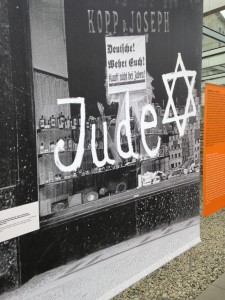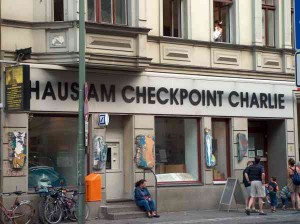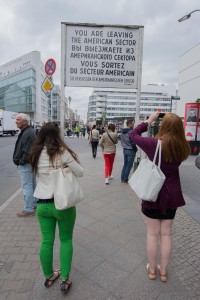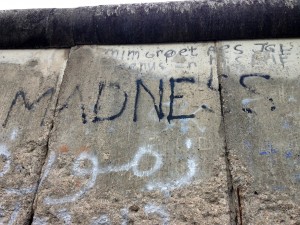
Part of the Berlin Wall, on the Topography of Terrors grounds, that reads “Madness”
(photo by Katie Pflug)
by Katie Pflug
Berlin, Germany’s Topography of Terror historic site is set on what used to be the site of the Reich Security Main office, but it is now a complex where visitors can learn more about the history of the Holocaust and the Nazi reign in Germany.
Even though National Socialist terror was planned and organized by other parties, the Reich Security Main Office was the center of most of the Nazi regime’s mass crimes and acts of terror. Between 1933 and 1945, the central institutions of Nazi persecution and terror – the Secret State Police Office with its own “house prison,” the leadership of the SS and, during the Second World War, the Reich Security Main Office – were located on the present-day grounds of the “Topography of Terror” that are next to the Martin Gropius Building and close to Potsdamer Platz, according to its website. It was just blocks away from the Suite Novotel, where the Point Park group stayed during its time in Berlin.
After the war the grounds were leveled and initially used for commercial purposes. Later, in 1987, as part of Berlin’s 750th anniversary celebration, the terrain was made accessible to the public under the name “Topography of Terror.” An exhibition hall and the exposed building remains on the former Prinz-Albrecht-Strasse (today’s Niederkirchnerstrasse) and Wilhelmstrasse were used to document the history of the site. The documentation center opened in 2010.
Now the grounds of the Topography of Terror have a haunted feel, almost as if visitors are being transformed back into that time period. It has part of the Berlin Wall as a backdrop, which adds more history and eeriness. There is a piece of the wall with the word “Madness” lightly written. This part of the wall stuck out to many visitors because many of them stopped and looked at the part of the wall particularly long. “The word [madness] describes how Germany was during that time period through the use of one word,” Andrea Karsesnick stated.
The outside exhibit begins with the year 1933, which is when the Nazi Party rise began. It was set up with large pictures, text, and propaganda posters. There are also other sections of the wall that are on their sides, with the metal exposed. The wall, in the form, looks like an art form.
It all starts in 1933 with “The Path to Dictatorship,” describing how Adolph Hitler came to power. This section of the exhibit is very time consuming but worth each second. It starts with describing the phase where Germany was between democracy and a dictatorship.
There is one picture in particular that stood out more than the others. The picture of the marching SS officers holding the flag with the Nazi symbol on it made it known to everyone that the Nazi Party was taking over. This photograph was taken in January 1933.
The Reichstag Fire and Nazi Terror in Berlin was another key section of the 1933 exhibit, explaining the burning of the Reichstag building. The burning of the Reichstag building, executed by a young Dutchman, Marinus van der Lubbe, led to the Nazi Terror taking place in Berlin.
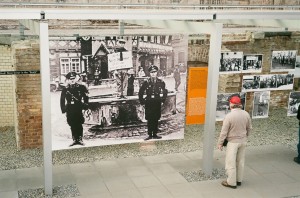
The Topography of Terror, a commemorative site in Berlin, details the Nazi Party’s rise to power in 1933 through the end of the war and the Nuremberg trials. Here Professor David Fabilli views some of the public shaming Jews endured in the years leading up to the Holocaust.
(Photograph by Helen Fallon)
There are many propaganda posters hanging around the exhibit. Each of them offers an explanation of what each poster is trying to persuade everyone to think is right. Each of the photographs and propaganda posters really brought the exhibit to life.
In the middle of the 1933 exhibit there are separate hanging posters to remember some of the victims of Nazi Terror in Berlin. All of the victims’ photographs are accompanied by their personal stories that would make anyone sick to his or her stomach.
For example, Franz Wilczoch, a laborer, was taken to the district court prison on June 22, 1933. The Nazis were using the district court prison as a detention and torture center. When he was there, they severely maltreated him. His face was beaten with burning torches, they poured hot tar onto his wounds, his hair was cut or torn out, and he was plastered with adhesive tape. He died from his injuries on June 30, 1933.
The exhibit then goes into events happening later in 1933, such as the Anti-Jewish Terror, purges and employment bans, Day of National Labor and the destruction of the trade unions, book burning, and the consolidation of power.
After the 1933 exhibit there is much more to see inside the documentation center, which continues the timeline until beyond 1945 – from the start of the war, the “shamings” and public humiliation of remaining Jews, SS officers retreats, persecution of prisoners and Hitler’s opponents, to the trials of the leaders.
The grounds are landscaped with trees and a large pathway, which makes it easy to stop for a second and remember the terrible events that happened on that very location.
The pathway leads around all of the grounds and finally makes its way back to the documentation center. Information on the Gestapo and SS offices are just a few of the examples of history that is around the pathway.
The center also includes a library, open from 10 a.m. until 5 p.m.; guided one-hour tours are also available. No admission fee is charged, and the site operates from 10 a.m. until 8 p.m. daily. Staff members start closing the documentation center at 7:45 p.m. It is all wheelchair accessible.
According to its website, 900,000 people visited the “Topography of Terror” in 2012, making the documentation center one of the most frequently visited places of remembrance in Berlin.
